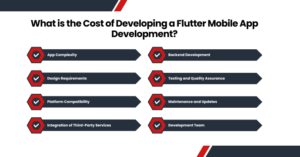In today’s digital age, where versatility and efficiency are paramount, businesses and developers are constantly on the lookout for technologies that streamline the app development process across multiple platforms.
Amidst the myriad of options available, Flutter has emerged as a frontrunner, revolutionizing cross-platform app development.
So, what sets Flutter apart, and why is it the go-to choice for developers worldwide? Let’s delve deeper into the reasons why Flutter is ideal for cross-platform app development.
What is Flutter?
Flutter is a free and open-source UI (User Interface) software development toolkit developed by Google. It allows developers to create natively compiled applications for mobile, web, and desktop platforms using a single codebase. Flutter enables developers to write code once and deploy it across multiple platforms, saving time and resources.
It provides a rich set of customizable widgets and a flexible UI framework that allows developers to create visually stunning and highly responsive user interfaces.
With features like hot reload for real-time code changes and performance optimizations for smooth animations and fast startup times, Flutter has become a popular choice for cross-platform app development.
Reasons for Flutter Being Ideal for Cross-Platform App Development
- Single Codebase, Multiple Platforms: Flutter allows developers to code once and deploy on iOS, Android, web, and desktop, saving time, ensuring consistency, and delivering high-quality native interfaces efficiently.
- Fast Development and Hot Reload: Flutter’s standout feature is its hot reload, enabling real-time code changes and immediate reflection in the app. This speeds up development and facilitates quick bug fixes, UI adjustments, and feature testing, boosting productivity.
- Stunning and Customizable UI: Flutter provides customizable widgets and a flexible UI framework for stunning, responsive interfaces. With native-like components and a vast plugin ecosystem, complex functionalities are easily integrated.
- Performance Optimization: Flutter shines in performance, leveraging Skia for high-performance rendering. Compiled to native machine code, it ensures superior performance, faster startup, and smooth animations.
- Strong Community Support and Growing Ecosystem: Flutter thrives on its active community, providing abundant support through forums, tutorials, and events. Google’s backing ensures sustainability and innovation, consolidating its position as a top cross-platform framework.
- Cost-Effectiveness and Time-to-Market: Utilizing Flutter’s cross-platform abilities cuts development costs and time-to-market. A single codebase streamlines processes minimizes overheads, and speeds up release cycles, giving businesses a competitive edge.
Read More: A Beginner’s Guide for Mobile App Development in 2024
What is the Cost of Developing a Flutter Mobile App Development?
Determining the cost of developing a Flutter mobile app involves various factors, each contributing to the overall expenses. Here’s an insight into what influences the cost:

- App Complexity: The complexity of your app, including features, functionalities, and design intricacies, directly impacts the development cost. Basic apps with standard features will be more affordable than complex apps with advanced functionalities.
- Design Requirements: The complexity of the app’s user interface (UI) and user experience (UX) design also affect the cost. Custom designs and animations require more time and resources, thus increasing the development expenses.
- Platform Compatibility: Flutter allows for cross-platform development, meaning you can build apps for both Android and iOS using a single codebase. However, optimizing the app for different platforms may incur additional costs.
- Integration of Third-Party Services: If your app needs to connect with third-party services like payment gateways, social media platforms, or analytics tools, the development cost will rise depending on the complexity of these integrations.
- Backend Development: The development of a backend infrastructure to support the app, including servers, databases, and APIs, adds to the overall cost. The complexity of the backend architecture and the need for scalability influence the expenses.
- Testing and Quality Assurance: Thorough testing and quality assurance (QA) are essential to ensure the app’s performance, security, and user experience. Allocating resources for testing processes adds to the development cost but is crucial for delivering a reliable app.
- Maintenance and Updates: Post-launch, ongoing maintenance and updates are necessary to keep the app functional and up-to-date with evolving technologies and user expectations. Budgeting for maintenance and updates is essential for the long-term success of the app.
- Development Team: The cost of hiring developers, designers, project managers, and other professionals involved in the app development process varies based on their experience, location, and hourly rates. Choosing between in-house development teams and outsourcing can also impact costs.
To estimate the cost of developing a Flutter mobile app, it’s essential to define your project requirements, outline the features and functionalities, and consider the factors mentioned above.
Consulting with app development agencies or freelancers can help provide more accurate cost estimates based on your specific needs and budget constraints.
Conclusion
Flutter’s versatility, efficiency, and performance make it an ideal choice for cross-platform app development. Its ability to deliver native-like experiences across different platforms, coupled with its fast development cycle and robust ecosystem, positions it as a frontrunner in the ever-evolving landscape of app development.
Whether you’re a seasoned developer or a budding entrepreneur, embracing Flutter can unlock a world of possibilities and propel your app to new heights of success.
So why wait? Dive into the world of Flutter and witness the magic of cross-platform app development unfold before your eyes.

I think flutter is best option.